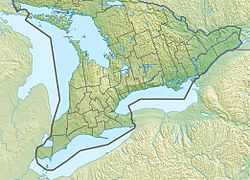| Coldwater River | |
|---|---|
 Coldwater River near the community of Coldwater | |
| Etymology | From the Ojibwa gisinaa nibiish, "cold pool of water" |
| Location | |
| Country | Canada |
| Province | Ontario |
| Region | Central Ontario |
| County | Simcoe |
| Physical characteristics | |
| Source | Unnamed lake |
| • location | Martinville, Oro-Medonte township |
| • coordinates | 44°34′30″N79°42′17″W / 44.57500°N 79.70472°W |
| • elevation | 246 m (807 ft) |
| Mouth | Matchedash Bay |
• location | Fesserton, Severn township |
• coordinates | 44°44′06″N79°39′03″W / 44.73500°N 79.65083°W |
• elevation | 176 m (577 ft) |
| Basin features | |
| River system | Great Lakes Basin |
| Tributaries | |
| • right | North River |
The Coldwater River is a river in Simcoe County in Central Ontario, Canada. [1] It is in the Great Lakes Basin and flows from the Oro moraine west of Lake Simcoe to Lake Huron. The river is believed to take its name from its Ojibwa name gisinaa nibiish, which means "cold pool of water".
Contents
The river offers canoe and kayak routes suitable for novice paddlers. A common launching point is in the village of Coldwater, Ontario.
